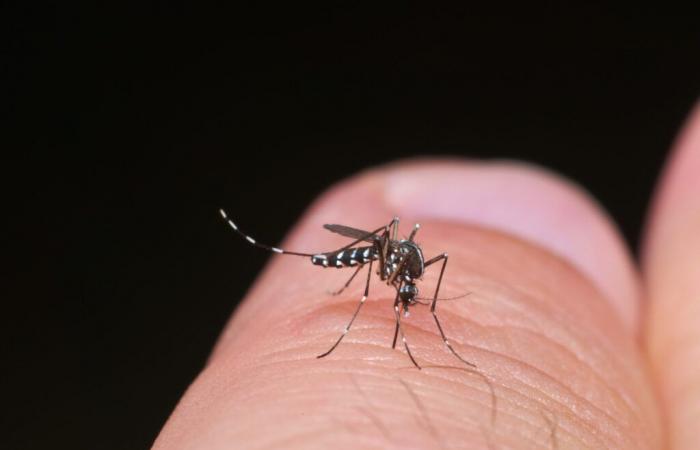
The establishment of the tiger mosquito in Île-de-France is a risk factor for vector epidemics such as dengue, chikungunya and even zika. In 2023, a first indigenous case of dengue fever was reported in Val-de-Marne. Update on epidemiological surveillance within the Val-de-Marne department (94).
In a context of climate change and globalization of trade, vector-borne diseases tend to appear in geographical areas previously spared, or, like malaria, to reappear in areas where they had disappeared. A vector-borne disease is transmitted by a vector, often a blood-feeding arthropod, such as a mosquito. By biting an infected person or animal, it ingests the parasites, viruses or bacteria contained in the blood. After an incubation period of a few days, the contaminated insect can transmit the pathogen to a healthy person through another bite. Every year, infected travelers returning from countries where these diseases are prevalent (Indian Ocean, Antilles, Guyana and South-East Asia in particular), are likely to introduce these viruses into mainland France.
Establishment of the tiger mosquito in mainland France
Installing the mosquito Aedes albopictus (commonly called “tiger mosquito”) contributes to the development of these pathologies. It is particularly present in the French departments of the Indian Ocean where it caused a very significant chikungunya epidemic in 2006. Its first installation in mainland France was noted in 2004 in Menton. Since 1is January 2024, the tiger mosquito is permanently established in 78 metropolitan departments. It is also present in Reunion and Mayotte. In the French departments of America (Guadeloupe, Martinique, Guyana), the vector causing the main epidemics of dengue, yellow fever, chikungunya and, since the end of 2015, Zika is the mosquito Aedes aegypti. Some native mosquito species can also carry West Nile virus (West Nile virus), or parasites responsible for malaria. The vectors of malaria are mosquitoes of the Anopheles genus. To date, there is no longer any local transmission of malaria in France, except in Mayotte and Guyana.
Val-de-Marne, particularly affected
The authorities are monitoring the establishment of this mosquito in mainland France because of its ability to transmit tropical diseases after biting sick people. Since 1is January 2020, all departments of the metropolitan territory are considered at risk of establishment and development of the tiger mosquito. This tropical mosquito is now established over a large part of the metropolitan territory. It is present in 78 out of 96 departments. The tiger mosquito is present and active in all departments of Île-de-France.
The epidemiological surveillance put in place makes it possible to classify each department according to five alert levels, ranging from green to purple, the latter representing the most critical level. All of the departments in the Ile-de-France region are on red alert, which means that the tiger mosquito is established and active there. Val-de-Marne stands out because it is on purple alert, which means that indigenous cases of vector-borne diseases have been recorded in the department. In October 2023, the ARS, in fact, confirmed a first indigenous case of dengue fever within the department, an unprecedented situation in Ile-de-France. A case is defined as indigenous when the person contracts the disease without having traveled to an endemic area in the fifteen days preceding the appearance of symptoms. Two successive mosquito control campaigns, the objective of which is to reduce the risk of spreading dengue fever, have been undertaken in the department, in the commune of Limeil-Brévannes. They were coupled with a field survey including door-to-door visits to local residents to detect other potential cases and relay prevention messages.
Strengthening the vector control system in Val-de-Marne
The ARS Île-de-France is responsible for implementing tiger mosquito surveillance and vector control actions in the Ile-de-France region. Reinforced with 1is May to November 30, the aim of the system is to prevent the proliferation of tiger mosquitoes and prevent the spread of diseases. This system is active throughout the region and governed by orders from the Ministry of Health, implemented at the local level in consultation with the prefectures and local authorities. It is based on the actions of the regional mosquito control agency (ARD): entomological surveillance, epidemiological surveillance and awareness raising among people residing in areas where the presence of mosquitoes is proven. These operations are part of the system to combat the spread of mosquitoes Aedes albopictus in mainland France set by instruction no. DGS/VSS1/2019/258 of December 12, 2019 and decree no. 2019-258 of March 29, 2019 relating to the prevention of vector-borne diseases. Three decrees of July 23, 2019 clarified the skills of the Regional Health Agency as well as the modalities for implementing entomological surveillance missions, intervention around detections and prospecting, treatment and work around places frequented by human cases of diseases transmitted by mosquito vectors and the list of departments where the establishment of the tiger mosquito constitutes a threat to the health of the population.
A fairly high risk of epidemic
Cases of dengue and chikungunya have increased in recent years in mainland France. Since 1is January 2024, in mainland France, more than 1,679 cases of dengue were imported into mainland France, compared to 131 cases over the same period in 2023. In an expert report published on September 13, 2024, ANSES estimates that the probability of appearance of An epidemic of arbovirosis, any virus combined, in the next five years is quite high. Dengue fever, like chikungunya or Zika, is an arbovirosis, that is to say a disease caused by a virus transmitted by arthropod vectors. In the event of an epidemic, the means of prevention and control of arboviruses could quickly be saturated. Managing cases of arboviruses, whether imported or indigenous, requires significant material, financial and human resources. The occurrence of an epidemic could have a health as well as economic and social impact, particularly on the health and tourism sectors, concludes ANSES.





